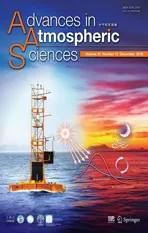Two Types of Flash Drought and Their Connections with Seasonal Drought
2018-10-16LinyingWANGandXingYUAN
Linying WANG and Xing YUAN
Key Laboratory of Regional Climate–Environment for Temperate East Asia,Institute of Atmospheric Physics,Chinese Academy of Sciences,Beijing 100029,China
ABSTRACT Flash drought is a rapidly intensifying drought with abnormally high temperature,which has greatly threatened crop yields and water supply,and aroused wide public concern in a warming climate.However,the preferable hydrometeorological conditions for flash drought and its association with conventional drought at longer time scales remain unclear.Here,we investigate two types of flash drought over China:one is high-temperature driven(Type I),while the other is water-deficit driven(Type II).Results show that the frequencies of the two types of flash drought averaged over China during the growing season are comparable.Type I flash drought tends to occur over southern China,where moisture supply is sufficient,while Type II is more likely to occur over semi-arid regions such as northern China.Both types of flash drought increase significantly(p<0.01)during 1979–2010,with a doubled rise in Type I as compared with Type II.Composite analysis shows that high temperature quickly increases evapotranspiration(ET)and reduces soil moisture from two pentads before the onset of Type I flash drought.In contrast,there are larger soil moisture deficits two pentads before the onset of Type II flash drought,leading to a decrease in ET and increase in temperature.For flash drought associated with seasonal drought,there is a greater likelihood of occurrence during the onset and recovery phases of seasonal drought,suggesting perfect conditions for flash drought during transition periods.This study provides a basis for the early warning of flash drought by connecting multiscale drought phenomena.
Key words: flash drought,climate change,soil moisture,evapotranspiration,seasonal drought
1.Introduction
Drought is usually considered as a slowly evolving phenomenon,taking several months or longer to reach its maximum intensity and spatial extent(Wang et al.,2011;Otkin et al.,2013;Xia et al.,2014;Yuan et al.,2017).Nonetheless,if drought is accompanied by several weeks of heat extremes,its onset and evolution can be very quick.The moisture deficits may be exacerbated by extremely high temperatures,and simultaneous occurrence of heat and drought extremes and their interactions have significant impacts on agriculture and water resources(Seneviratne et al.,2006;Hao et al.,2013).In a warming climate,heat extremes have become more frequent and substantially increased the concurrent probability of regional drought and heat waves since the middle of the 20th century(Nicholls,2004;Hao et al.,2013;Diffenbaugh et al.,2015).This raises the attention on investigating various types of extremes integratedly(AghaKouchak et al.,2014;Leonard et al.,2014).
During the summer of 2012,considerable damage to crops and billions of dollars of economic losses that were caused by a rapidly intensifying drought,which was also termed as“ flash drought”across the central U.S.,raised wide public concern(Boyer et al.,2013;Otkin et al.,2013;Hoerling et al.,2014;Mo and Lettenmaier,2015).Most regions over the central United States with normal soil moisture conditions in early May experienced strong depletion in two to three weeks,which is a much faster time scale than for conventional drought(Mo and Lettenmaier,2015).Similar flash drought events have also been reported in East Asia(Yuan et al.,2015a),Europe(Mozny et al.,2012;Potop et al.,2014)and southern Africa(Yuan et al.,2018).A persistent deficit of precipitation,anomalously warm surface temperatures,and abundant sunshine,can enhance the local evaporation demand considerably,leading to a rapid reduction in moisture availability for vegetation.A short period of intense moisture stress can result in large crop yield losses if it occurs during critical crop growing stages,such as emergence,pollinationor grain filling(Meyeretal.,1993;Saini and Westgate,1999;Earl and Davis,2003;Barnabás et al.,2008;Kebede et al.,2012;Hunt et al.,2014;Xie et al.,2016).Moreover, flash drought also has significant impacts on livestock health, fire potential,and the ecological environment,due to concurrent heat stress(Svoboda et al.,2002).
While numerous studies have addressed the evolution and causes of drought and extreme heat individually, their concurrent events(e.g., flash drought)have received less attention.The concept of “ flash drought”was first proposed by Svoboda et al.(2002),with the intent to describe a rapid drought breaking type of event.Subsequently,the impacts of flash drought on vegetation have been investigated by a number of remote sensing studies with several ecological drought metrics,such as the Evaporative Stress Index(Anderson et al.,2013),Evaporative Demand Drought Index(Hobbins et al.,2016),and solar-induced chlorophyll fluorescence(Sun et al.,2015)etc.In addition,Ford et al.(2015)used weekly soil moisture measurements to identify drought onset in Oklahoma and found that in-situ soil moisture can provide advanced warning information at a lead time of two to three weeks earlier than the U.S.Drought Monitor.Otkin et al.(2016)explored the evolutionary features of soil moisture and vegetation health conditions during a flash drought in 2012 and the associated impacts on crops based on high resolution modelling,satellite-derived data,and survey data.In short,most previous studies investigated the early detection and vegetation response for specific flash drought events(Hunt et al.,2014;Ford et al.,2015;Yuan et al.,2015a;Otkin et al.,2016),but there has not been a widely accepted definition for flash drought so far,and few studies have investigated flash drought characteristics from a climatological perspective with long-term datasets.
Recently,Mo and Lettenmaier(2015,2016)defined flash drought based on the variation of temperature,evapotranspiration(ET)and soil moisture during the drought’s evolution,and classified them into two categories according to their different mechanisms:one is high temperature driven,combined with increased ET and decreased soil moisture;while the other is initialized by a lack of rainfall,and hence decreasing ET and anomalously warmer temperatures.For both types of flash drought,their variations and mechanisms were explored over the conterminous United States based on observed temperature and model-reconstructed soil moisture and ET(Mo and Lettenmaier,2015,2016).Besides studies in the United States,Wang et al.(2016)investigated the longterm variability and underlying causes of high temperaturedriven flash drought over China and revealed an increasing trend of flash drought mainly associated with long-term warming.Yuan et al.(2018)found that water deficit-driven flash drought over southern Africa had tripled in the last 60 years and intensified during the 2015/16 rainy season in the midst of a heat wave.However,most previous studies have overlooked the interactions between multiscale drought processes(e.g.,the association between flash drought and conventional seasonal drought),which are especially important for a drought-prone region like China(Qian et al.,2011),where multiscale processes(e.g.,ENSO,monsoon,blocking)affect drought/ flooding events.
Flash drought is a rapidly intensifying water deficit process accompanied by high temperatures in a very short time(e.g.,several days to weeks),while conventional drought is not necessarily associated with heat extremes and the time scale is much longer(Mo and Lettenmaier,2016).The rapidly evolving nature of flash drought places a heavy burden on farmers and ranchers,thereby leading to greater adverse societal and economic effects than those stemming from slower-developing drought.It is also uncertain whether there are potential connections between flash drought and conventional drought due to different time scales.In addition,it is worth noting that northern China is a semi-arid region where conventional drought occurs frequently,while the flash drought risk over humid and semi-humid regions like southern China is also urgent under global warming(Wang et al.,2016).Therefore,as the physical mechanisms of the two types of flash drought differ,their spatiotemporal characteristics and connections with conventional drought at longer time scales over China need careful investigation.
In this study,we begin by exploring the spatial patterns of the occurrence and duration of both types of flash drought,as well as their seasonal and interannual variability.Then,we evaluate the composite hydrometeorological conditions to investigate the evolutionary characteristics of flash drought.Furthermore,the potential connections between flash drought and seasonal drought are discussed,with the aim to provide guidelines for drought monitoring,early warning,and mitigation.
2.Data and methods
2.1.Multisource datasets
As flash drought often occurs in the growing season with a rapid onset(Mo and Lettenmaier,2015),we used daily surface air temperature and precipitation measurements from 2474 China Meteorological Administration meteorological stations(http://data.cma.cn/en)from April to September during the period 1961–2014(Yuan et al.,2015a).Due to the lack of direct observations,the soil moisture and ET used here are from three global reanalysis products:the NCEP’s Climate Forecast System Reanalysis six-hourly datasets with a spatial resolution of 0.3125°for 1979–2010(Saha et al.,2010);ERA-Interim three-hourly datasets regridded to 0.25°for 1979–2010(Simmons et al.,2007);and Global Land Data Assimilation System version 2(GLDAS-2)three-hourly datasets with a spatial resolution of 0.25°for 1961–2010(Rodell et al.,2004).With the consideration of the vegetation root zone,the top 1 m soil moisture was used to detect flash drought,which is a different approach to that used in our previous study(Wang et al.,2016).
First,we calculated the daily mean soil moisture and ET for each reanalysis product,and then matched the grid data to the corresponding or nearest station.Second,the quantile mapping method(Wood et al.,2002)was used to match the cumulative distribution functions of the observations and GLDAS-2 products to fill the missing station measurements for temperature and precipitation.Excluding the mismatched stations in coastal areas,there were still 2452 stations left for the quantile mapping.Finally,three continuous station datasets including the observations and reanalysis products covering the period 1979–2010 at the daily time scale were generated.The correlations between precipitation and soil moisture are similar for each dataset and the ensemble mean(not shown),and larger than 0.5 over most parts of China[Fig.S1a in the Electronic Supplementary Material(ESM)].Meanwhile,the relationship between temperature and ET is rather complex,being positive in southern China and negative in part of northern China(Fig.S1b).In addition,sixhourly 500-hPa geopotential height from ERA-Interim products with a spatial resolution of 1°was used to study the weather conditions for flash drought.Pentad-mean anomalies for temperature,precipitation,ET and 500-hPa geopotential height,as well as the percentiles for pentad-mean soil moisture,were calculated.More details can be found in Wang et al.(2016).
2.2.Definitions of flash drought events
We used similar definitions as Mo and Lettenmaier(2016)for the two types of flash drought,but focused on drought events instead of drought pentads.In addition,we consistently used soil moisture as a water-deficit indicator for both types of flash drought.Thus,both types of flash drought could be defined based on temperature,ET and pentad-mean soil moisture quantile valuesq(θpentad)(%)as:

Here,Tano(°C)is the anomaly for the pentad-mean surface air temperature,Tstd(°C)is the standard deviation of theTanotime series,and ETano(mm d−1)is the anomaly for the pentad-mean ET.For each station and each pentad,if the temperature anomaly is larger than one standard deviation,the ET anomaly is positive,and the soil moisture percentile is less than 30%,the first type of flash drought pentad is identified.And if two or more consecutive pentads meet the requirements,they are classified within one flash drought event(Type I).Although the criteria used here to define flash drought are associated with the variational characteristics of hydrometeorological variables,the “ flash”feature is also implied when high temperatures coincide with the other two factors.For the second type of flash drought event(Type II),all conditions are identical to Type I except the ET anomaly is negative.The main physical difference between the two types of flash drought is that Type I is high-temperature driven,thereby causing increased ET,while Type II is water-deficit driven,leading to reduced ET and increased temperature.
In this study,the identification of Type II flash drought is a little different from that of Mo and Lettenmaier(2016),as we used a soil moisture percentile of less than 30%instead of a precipitation percentile of less than 40%for a consistent comparison with Type I.In fact,we compared the frequency of occurrence for Type II flash drought under different percentile thresholds for precipitation or soil moisture(Fig.S2 in ESM),and the results showed that the spatial patterns were similar under the different thresholds,and the discrepancies in magnitude for the frequency were not very large.As flash drought is an agricultural drought in nature(Mo and Lettenmaier,2015),we used soil moisture for the identification of drought,and the 30%threshold was selected to facilitate comparison between the two types of flash drought.
2.3.Definition of seasonal drought events
A seasonal drought event is defined as a consecutive sequence of months with monthly soil moisture percentileq(θmonth)that drops below 30%(Yuan et al.,2015b):

whereD(months)is the duration of the seasonal drought.
In contrast to flash drought during a growing season,the period for identifying seasonal drought is the full calendar year.To quantify the potential association between flash drought and seasonal drought,we calculated the ratio of flash drought during different phases of seasonal drought(i.e.,onset,persistency,recovery)to the total number of flash drought events.Both flash drought and seasonal drought events from each dataset were identified separately,and an average of the three datasets was used.Similarly,the ratios for different datasets were calculated separately before obtaining the ensemble mean.
3.Results
3.1. Spatiotemporal distribution of the two types of flash drought over China
The frequency of both types of flash drought shows large spatial variability(Fig.1).Type I flash drought is most likely to occur over humid regions,such as southern China(12–18 events per decade),with short duration(six to seven days on average),followed by northeastern China and northern China(three to nine events per decade and five days on average)with semiarid climate(Figs.1a and b).This pattern is similar to the findings of our previous study(Wang et al.,2016),although the magnitude is a little smaller due to the modification of the soil moisture threshold.In contrast,Type II flash drought occurs frequently over northern China(Fig.1c),with an average duration of seven to eight days(Fig.1d).The contrasting spatial distribution of the frequency and duration of flash drought is mainly associated with the local climate,vegetation and soil moisture conditions.In humid and semihumid regions,where the moisture supply is sufficient,ET is mainly restricted by available energy,so high temperatures can raise ET quickly(Fig.S1 in the ESM).In addition,dense vegetation in humid regions can facilitate root water uptake under drought conditions.Therefore,the concurrent heat,drought and enhanced ET events that are critical conditions for triggering TypeI flash drought,tend to occur in humid and semi-humid regions with longer duration during the growing season.In arid and semiarid regions,meanwhile,due to the terrestrial moisture-supply limitation and sparse vegetation,ET decreases with the decrease in soil moisture,resulting in Type II flash drought with a longer duration.
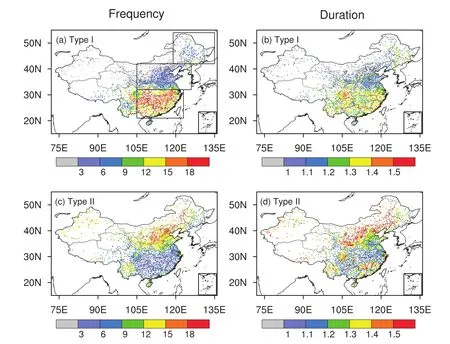
Fig.1.Ensemble-mean(a,c)frequency(events per decade)and(b,d)duration(pentads)for the two types of flash drought during the growing season(April to September)for the period 1979–2010.The ensemble means are the averages of the frequency and duration from each reanalysis product.The boxes in(a)represent the locations of three subregions:southern China(21°–32°N,105°–123°E),northern China(32°–42°N,105°–126°E)and northeastern China(42°–54°N,119°–135°E).
Figure 2 shows the monthly variations of flash drought and its component variables(temperature,ET,soil moisture)under drought conditions averaged over China and its subregions during 1979–2010.The monthly cumulative number of pentads for Type I flash drought varies from five to eight,with the largest number in July,over China.It is worth mentioning here that the monthly cumulative number of pentads for Type I flash drought over southern China is about two to three times that over northern China and northeastern China.For Type II flash drought,the monthly cumulative drought number of pentads is about four in southern China,which is only half that in northern China,with a larger number in late spring and early summer.The monthly mean temperature anomaly under both types of flash drought conditions is about 3°C,and the seasonal cycle shows similar variations over different regions(Figs.2b and f).The main difference between the two types of flash drought occurs in ET and soil moisture(Figs.2c,d and 2g,h).The average ET anomaly and soil water deficit under Type I drought conditions over southern China are about 0.7 mm d−1and 15%respectively,which are larger than those over northern China.In contrast,the negative ET anomaly under Type II flash drought conditions is larger over northern China(−0.7 mm d−1).The soil moisture deficit,meanwhile,is similar across different regions for Type II flash drought,and is much larger(11%)than that under Type I drought conditions.
Figures 3a and b show the spatial pattern of the Mann–Kendall trend for both types of flash drought over the period 1979–2010.In general,the frequency for both types of flash drought over China is increasing,despite obvious interannual variability(not shown).Type I flash drought increases by 129%,with a statistical significance ofp<0.01,and Type II flash drought increases by 59%(p<0.01),during 1979–2010.There is a significantly increasing trend for Type I flash drought over most regions across China,especially for southern China.For Type II flash drought,the increasing trends are obvious mostly over northern and northeastern China.The increase in flash drought is consistent with the warming trend of temperature over most regions of China(Fig.3d).For ET,there is a significantly increasing trend over southern China and a decreasing trend in part of northern China,which may explain the different trend patterns for the two types of flash drought.The trend for soil moisture is not significant in most regions of China,except for the drying trend over northeastern China and part of central China,and the wetting trend over Shandong and western China(Fig.3e),which is similar to the pattern of the precipitation trend(Fig.3c).
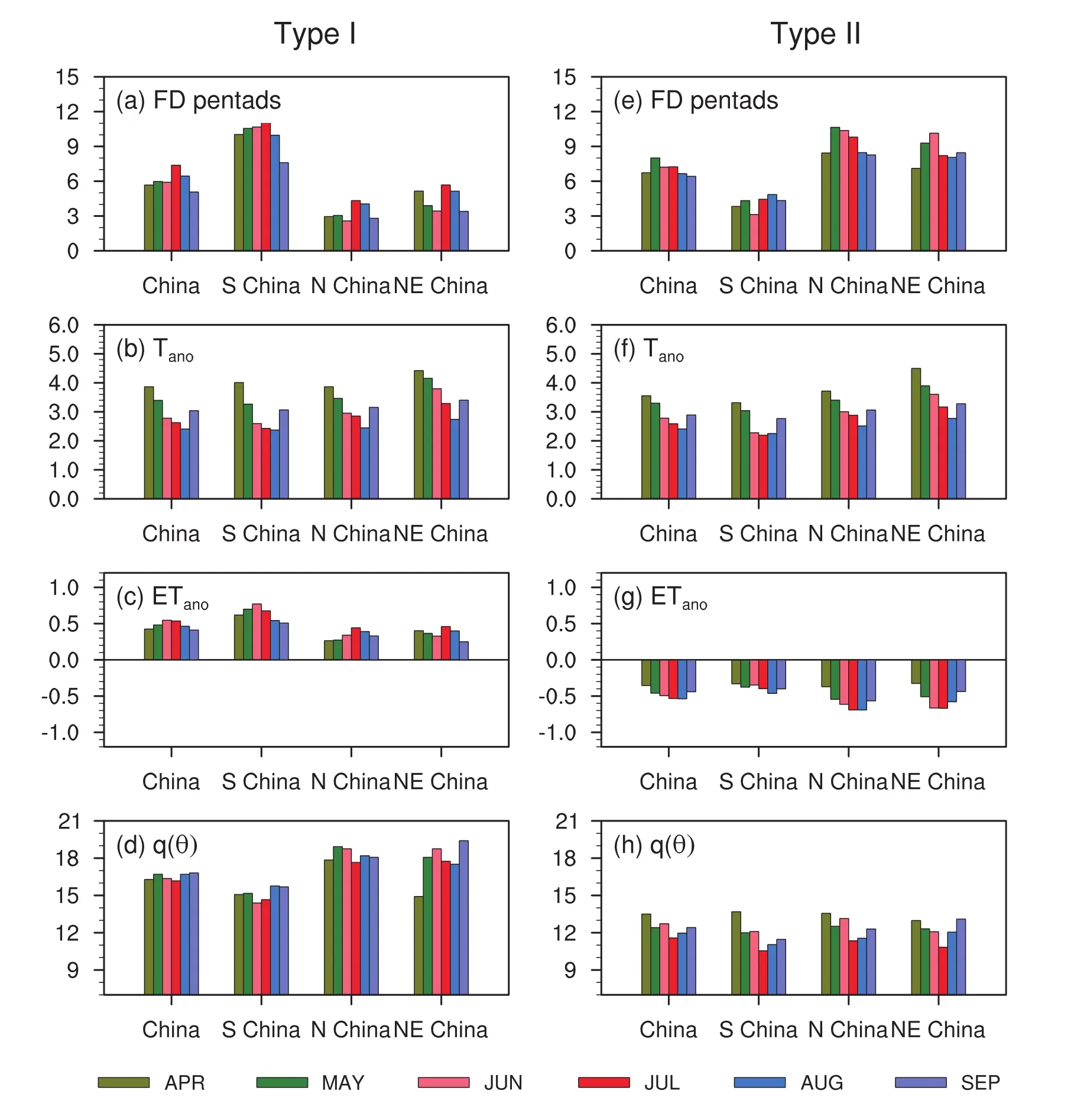
Fig.2.(a,e)Total number of flash drought pentads(FD pentads)for each month during the growing season.Pentad mean(b,f)temperature anomalies(Tano)(units: °C),(c,g)ET anomalies(ETano)(units:mm d−1),and(d,h)soil moisture percentiles[q(θ)](units:%),averaged over each growing month during 1979–2010.The results were calculated over each observation station point,and averages over China and its subregions are shown here.
3.2.Evolution of flash drought
To further explore the evolutionary characteristics for the two types of flash drought,the composite hydrometeorological conditions before and after drought were examined and their statistical significances(the same for all composite analysis hereafter)were tested at the 95%confidence level using the bootstrap method(Austin and Tu,2004)1000 times.Figure 4 shows that the evolution of temperature under flash drought is very quick,especially over hotspot regions.For Type I flash drought,the temperature is close to the climatology over southern China(hotspot of Type I)two pentads before onset(Fig.4a).Anomalously warm temperature(~0.5 standard deviations)occurs one pentad before onset,and rises quickly—with the maximum value reaching 1.5 standard deviations—during onset,as compared to the climatology(Figs.4b and c).High temperatures disappear soon after,within one or two pentads,for Type I flash drought over southern China(Figs.4d and e).Similarly,the evolution of temperature under Type II flash drought is also very quick over the hotspot of northern China(Figs.4f–j).For regions with less-frequent flash drought,such as northern China for Type I and southern China for type II,the temperature variation before onset is smaller,suggesting the necessity for warm temperature for flash drought to be triggered.Precipita-tion has similar variations during the evolution of both types of flash drought,albeit the deficits are larger under Type II drought conditions.
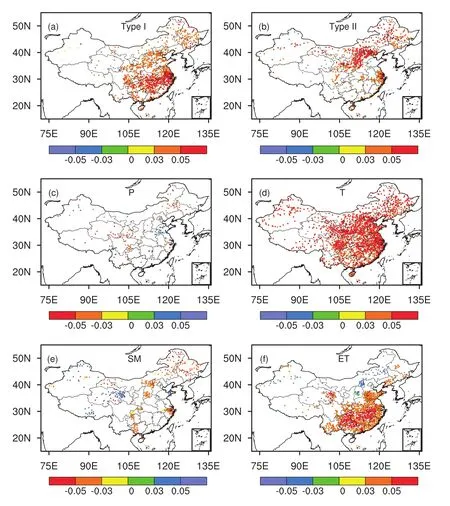
Fig.3.Mann–Kendall trends for the ensemble-mean(a,b)number of flash drought events,(c)standardized precipitation,(d)standardized surface air temperature,(e)standardized soil moisture,and(f)standardized ET,during the growing seasons of 1979–2010.Only stations with statistically significant trends at the 95%level are shown here.
The major evolutionary difference between the two types of flash drought can be found in the hydrological conditions(Fig.5).For Type I flash drought,high temperatures lead to a rapid increase in ET,with the maximum positive ET anomalies larger than one standard deviation during drought onset over southern China(Fig.5c).The soil moisture percentile is about 30%–40%during the two pentads before onset(Fig.5k).It decreases quickly,at a speed of 10%per pentad,with a minimum value of 10%–20%over southern China(Figs.5k–m).For Type II flash drought,the water deficit is the dominant driver,and soil moisture deficits are already large(20%–30%)two pentads before drought onset(Fig.5p).The speed of reduction is also about 10%per pentad,and large areas experience the driest soil conditions(10%–20%)one pentad before onset(Fig.5q).The intense water stress results in rapid reduced ET,with the largest negative anomalies of one standard deviation over northern China during onset(Fig.5h).In should be noted that the soil moisture deficits are still very large two pentads after flash drought(Figs.5o and t),which may evolve into seasonal drought if the precipitation deficit persists.
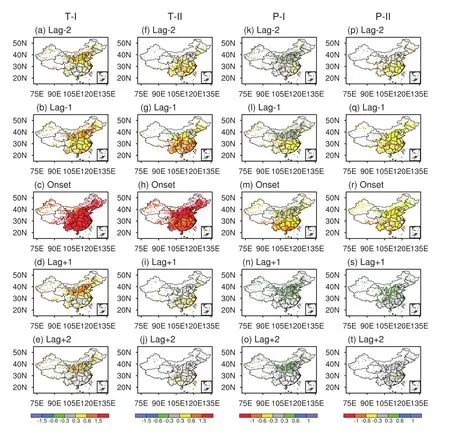
Fig.4.Ensemble-mean composites of standardized temperature anomalies(a,f)two pentads before onset,(b,g)one pentad before onset,(c,h)at onset,(d,i)one pentad after onset,and(e,j)two pentads after onset,of flash drought events during 1979–2010.Panels(k–t)are the same as(a–j)but for standardized precipitation anomalies.Bootstrapping was performed 1000 times to estimate the uncertainty,and only stations with anomalies exceeding the 95%confidence level are shown.
Composite analyses of circulation anomalies were also computed for different periods of flash drought.We first calculated the pentad-mean 500-hPa geopotential height anomalies for each station over the most likely regions of occurrence,i.e.,southern China(21°–32°N,105°–123°E)for Type I flash drought and northern China(32°–42°N,105°–126°E)for Type II.The average anomaly pattern over the preferred regions represents the associated atmospheric circulation.Figure 6 shows the development of atmospheric anomalies during different periods of flash drought.There are anticyclonic anomalies during the onset for both types of flash drought(Figs.6b and e),with a stronger anomaly for Type II(Fig.6e).The anomalies of geopotential height one pentad before flash drought onset are not significant,suggesting difficulty in seeking precursors that can facilitate the early warning of flash drought.To further explore the physical mechanism of flash drought,we calculated the circulation anomalies before and after heat extremes,defined as temperature anomalies larger than one standard deviation.Interestingly,the development of atmospheric anomalies under heat extremes is similar to that under flash drought,albeit the location and intensity of the anomalies for specific regions are a little different(Figs.S3 and 6).For example,the 500-hPa geopotential height anomalies during the onset of flash drought are more obvious than those under heat extremes.The anticyclonic anomalies provide favorable conditions for abnormally high temperatures through enhanced descending motion(Hu et al.,2012;Wang et al.,2017),possibly triggering flash drought when accompanied by local dry land conditions.The results imply the importance of heat extremes in the establishment of flash drought,as well as a lower predictability of flash drought compared with heat extremes.
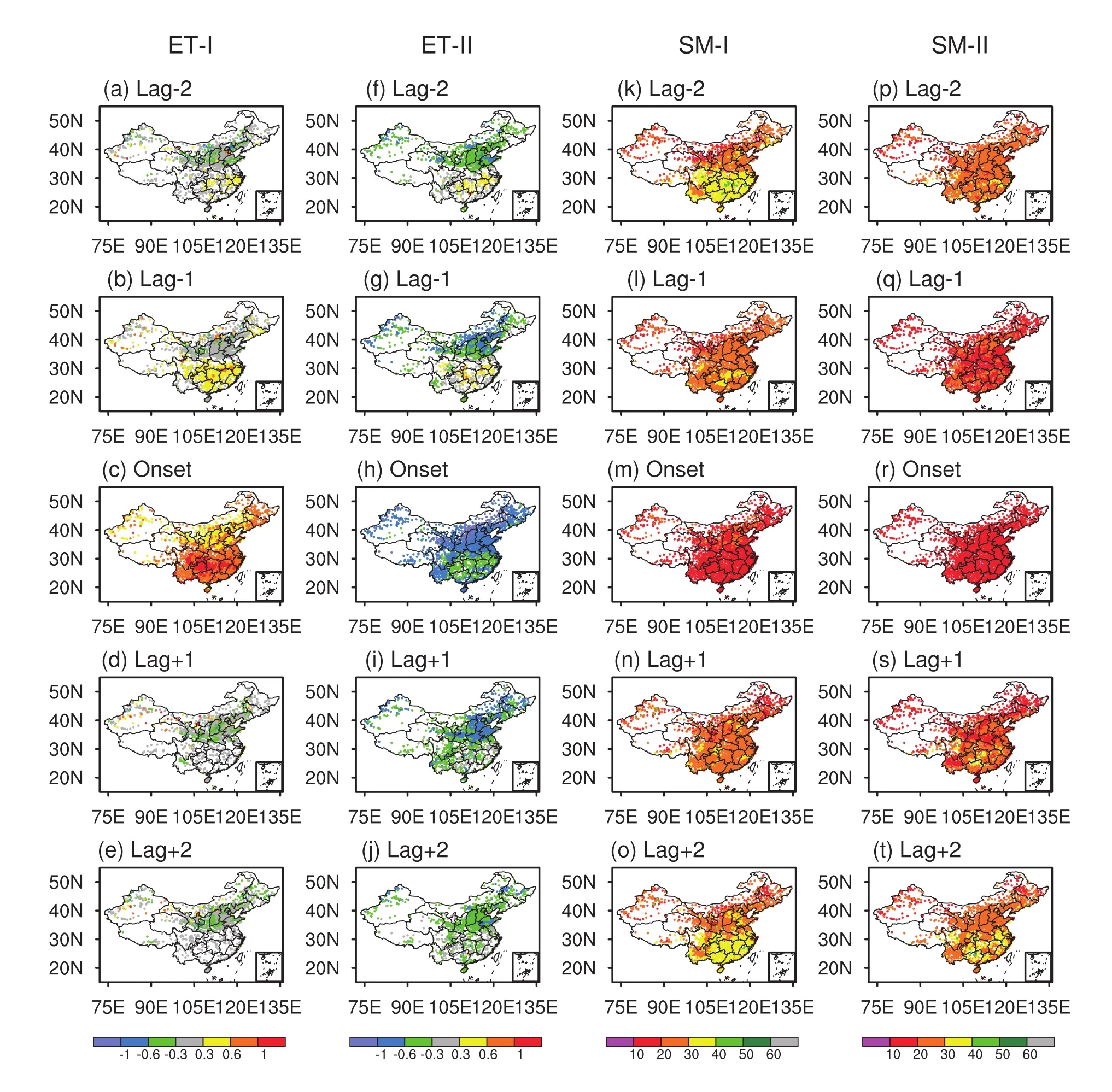
Fig.5.As in Fig.4 but for(a–j)standardized ET anomalies and(k–t)soil moisture percentiles.
3.3.Connection with seasonal drought
To analyze the relationship between flash drought and seasonal drought,the frequency and duration for seasonal drought were calculated based on the monthly soil moisture.When soil moisture percentiles are less than 30%for more than three consecutive months,it can be considered as a seasonal drought event.Figure 7a shows that seasonal drought is more likely to occur over northern China,which is similar to Type II flash drought(Fig.1c).The ensemble-mean duration of seasonal drought over most of northern China is at least six months,and even longer than one year in some regions,which is longer than that over southern China where the duration is four to six months(Fig.7b).
To quantify the potential connection between flash drought and seasonal drought,we calculated the ratio of flash drought pentads that occurred during different phases of seasonal drought relative to the total number of flash drought pentads(Fig.8).The ratio of Type I flash drought pentads that occurred during seasonal drought shows a north-to-south decreasing gradient over China(Fig.8a).About 15%of flash drought occurs within the onset phase of seasonal drought over southern China,which is much larger than within the persistency(9%)and recovery(10%)phases of seasonal drought(Figs.8b–d and 9b–d).In northern China,meanwhile,the soil moisture is relatively low,and the ET anomaly is more likely to become negative under drought conditions until rainfall relieves the water deficit at the end of the seasonal drought.Therefore,the periods with a greater tendency include both the onset(19%)and recovery(18%)phases of seasonal drought for Type I flash drought over northern China(Figs.8b–d and 9b–d).The spatial patterns for the ratios of Type II flash drought are similar to Type I(not shown),though the magnitudes are a little larger(Fig.9).
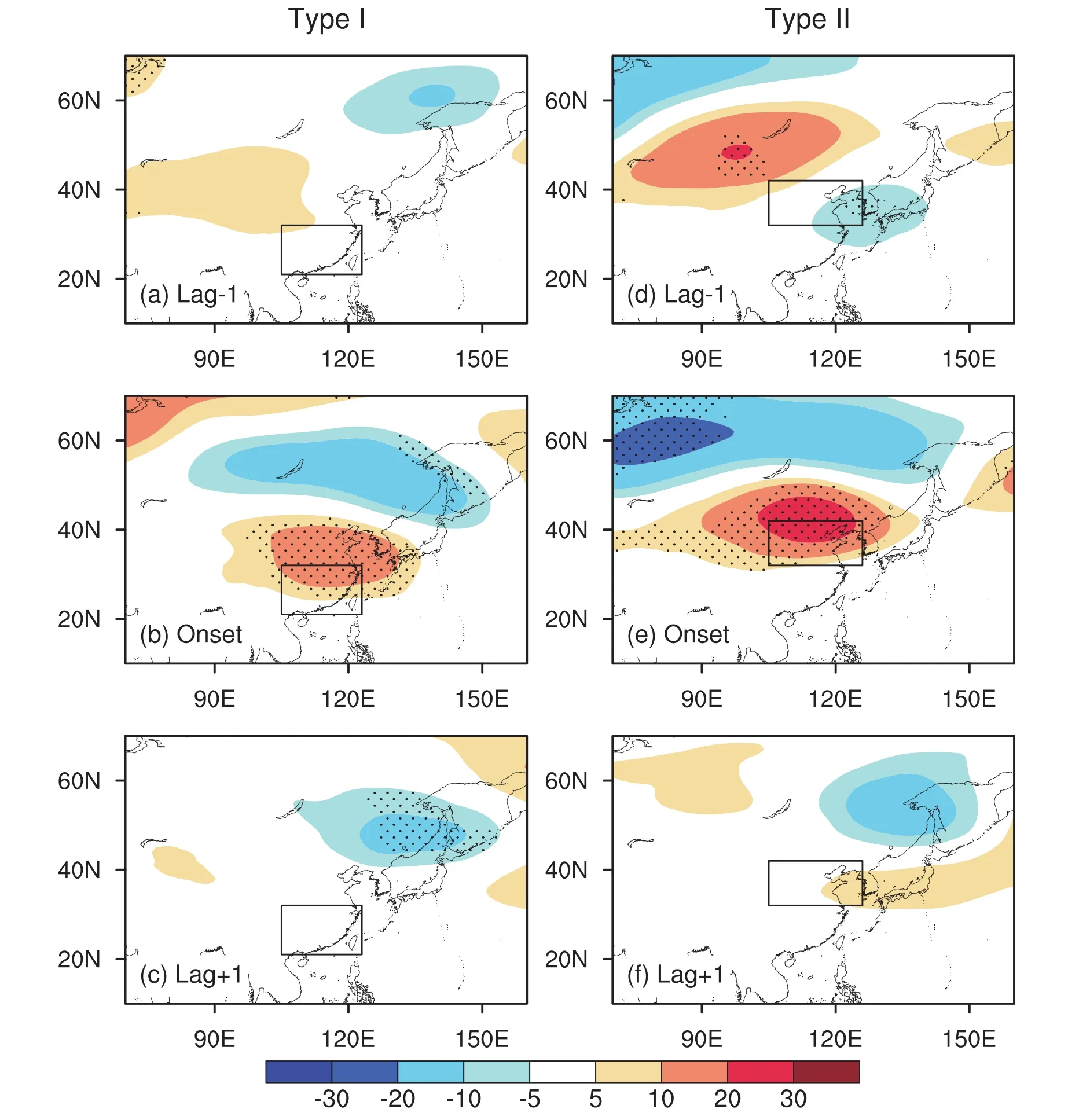
Fig.6.Ensemble-mean composite patterns for 500-hPa geopotential height anomalies(units:gpm)during(a,d)one pentad before onset,(b,e)at onset,and(c,f)one pentad after onset,of flash drought events.The black dots represent regions with anomalies exceeding the 95%confidence level estimated using bootstrapping 1000 times.
It is worth noting that the averaged ratios of both types of flash drought over China are less than 50%during the whole period of seasonal drought,and the ratio is even lower(10%–30%)in some regions of southern China(Figs.8a and 9a).To examine the remaining flash drought events,we relaxed the definition of seasonal drought from at least three dry months to at least one dry month.If two or more months met the requirement,it was considered as one seasonal drought event.In other words,one-month and two-month drought events were also included in the pool of seasonal drought events.We found that the regional averaged ratio of flash drought during the seasonal drought period increases to 60%–70%(Fig.9a).This implies that there is a relationship between flash drought and subseasonal to seasonal drought,but the mechanism of their interaction needs further study.
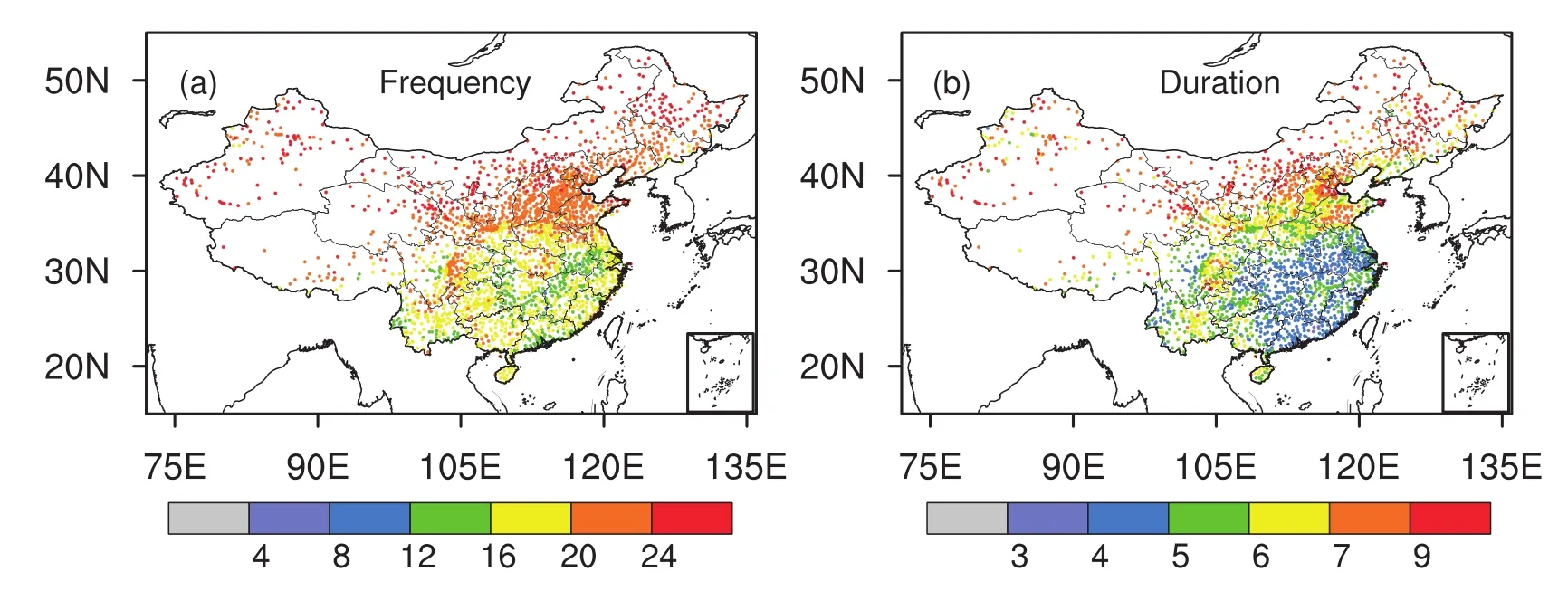
Fig.7.Ensemble-mean(a)frequency(units:%)and(b)duration(units:months)for seasonal soil moisture droughts during 1979–2010,averaged from three reanalysis datasets.The frequency is defined as the percentage of drought months compared to the total number of months.
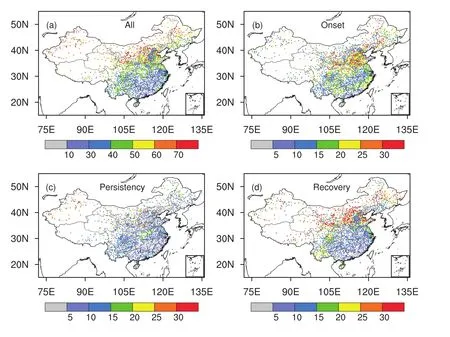
Fig.8.Ratios(units:%)of Type I flash drought events during different phases[(a)whole period;(b)onset;(c)persistency;(d)recovery]of seasonal drought to the total number of Type I flash drought events at each station.
4.Conclusions and discussion
Flash drought is a rapidly evolving agricultural drought in the growing season,accompanied by extreme heat and severe soil water deficit,which may lead to crop failure.According to different physical mechanisms,there are two types of flash drought with different spatial patterns and seasonal cycles.In this study,based on pentad-mean surface air temperature observations from over 2000 meteorological stations,as well as soil moisture and ET estimations from three global reanalysis products,the spatiotemporal characteristics for both types of flash drought and their associations with conventional seasonal drought over China were explored.
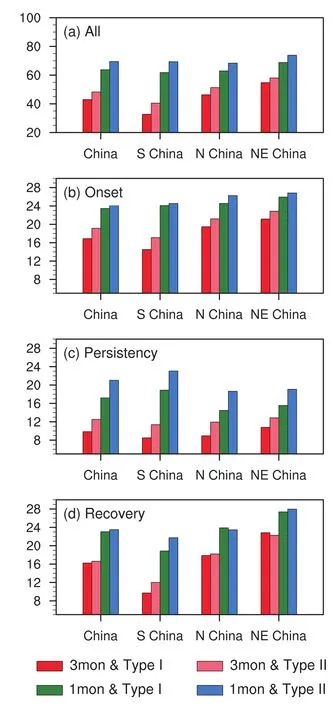
Fig.9.Ratios(units:%)of flash drought events during different phases of seasonal drought averaged over China and its subregions.Seasonal drought is defined as a soil moisture percentile less than 30%for at least three consecutive months or one month.
Type I flash drought is high-temperature driven and more likely to occur in July over humid and semi-humid regions,where moisture supply is sufficient,such as southern China,with an average occurrence of 12–18 events per decade.Type II flash drought is mainly water-deficit driven and tends to occur in late spring and early summer over northern China.Accompanied by warming temperatures over 1979–2010,Type I flash drought increased by 129%(p<0.01)and Type II by 59%(p<0.01)over China.Composite analysis showed that anomalously high temperatures one pentad before onset of Type I flash drought leads to a rapid increase in ET,with maximum anomalies of more than one standard deviation,and a reduced soil moisture percentile,at a speed of 10%per pentad,over southern China.For Type II flash drought,large deficits of moisture two pentads before onset quickly reduce ET and hence raising temperatures.The anticyclonic circulation patterns also provide favorable conditions for both types of flash drought.The evolutionary patterns for hydrometeorological conditions and atmospheric circulation under flash drought over China are similar to those over the United States(Mo and Lettenmaier,2016).For flash drought associated with seasonal drought,there is a greater likelihood of occurrence during the onset phase of seasonal drought over southern China,with a mean ratio of 15%,while over northern China occurrence is more common in both the onset(19%)and recovery(18%)phases.The regionally averaged ratios increase to 60%–70%if one-month and two-month drought events are included.
Our study shows that,although the causes are different,the trends for both types of flash drought are increasing significantly across most regions of China with the longterm warming of temperature,which is inconsistent with the trend over the United States.There,it has been found that temperature-driven flash drought has decreased significantly,especially over the north-central region,due to the increased precipitation,whereas water-deficit flash drought has increased over the southwest region,which is associated with the climate warming(Mo and Lettenmaier,2016).Given the unexpected rate of intensification,increased trend of occurrence,and large impacts over China,our results highlight the urgent need to develop an efficient early warning system for flash drought.We have found that the onset and evolution of flash drought are usually accompanied by heat waves,antecedent moisture deficits,and abundant sunshine,as well as anomalous atmospheric circulation,but there are still great challenges to overcome to achieve reliable early detection and predictions.For instance,without a strong anomalous sea surface temperature,the occurrence of the 2012 flash drought in the central United States was mainly associated with variations in atmospheric dynamics and land–atmosphere interaction,which caused a persistent ridge of upper-tropospheric high pressure anomalies and thereby the abnormally high temperatures at land surface(Hoerling et al.,2014).Due to a lack of knowledge on the precursors and physical processes,recent modeling studies have shown limited skill in predicting this 2012 flash drought(Kumar et al.,2013;Hoerling et al.,2014).Thus,it is essential to understand the dynamic and thermodynamic processes of land–atmosphere interaction and identify key precursors for flash drought.In addition,the interaction between flash drought and subseasonal to seasonal drought also needs to be considered for drought prediction and mitigation.
Acknowledgements.This work was supported by the National Key R&D Program of China(2018YFA0606002),the National Natural Science Foundation of China(91547103),the China Special Fund for Meteorological Research in the Public Interest(Grant No.GYHY201506001),and the General Financial Grant from the China Postdoctoral Science Foundation(2018M631553).The authors gratefully acknowledge the NCEP(http://cfs.ncep.noaa.gov/cfsr), ECMWF (http://data.ecmwf.int),and Goddard Earth Sciences Data and Information Services Center(http://disc.sci.gsfc.nasa.gov/hydrology/data-holdings)for providing the reanalysis products,and the China Meteorological Ad-ministration for providing the surface air temperature and precipitation observations(http://data.cma.cn/en).
Electronic supplementary material:Supplementary material is available in the online version of this article at https://doi.org/10.1007/s00376-018-8047-0.
杂志排行
Advances in Atmospheric Sciences的其它文章
- A 31-year Global Diurnal Sea Surface Temperature Dataset Created by an Ocean Mixed-Layer Model
- Nocturnal Low-level Winds and Their Impacts on Particulate Matter over the Beijing Area
- Impact of Interannual Variation of Synoptic Disturbances on the Tracks and Landfalls of Tropical Cyclones over the Western North Pacific
- Electronic Supplementary Material to:Two Types of Flash Drought and Their Connections with Seasonal Drought∗
- Estimating the Predictability Limit of Tropical Cyclone Tracks over the Western North Pacific Using Observational Data
- Impact of Mid-and Upper-Level Dry Air on Tropical Cyclone Genesis and Intensification:A Modeling Study of Durian(2001)
